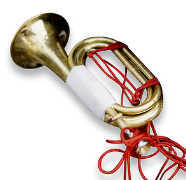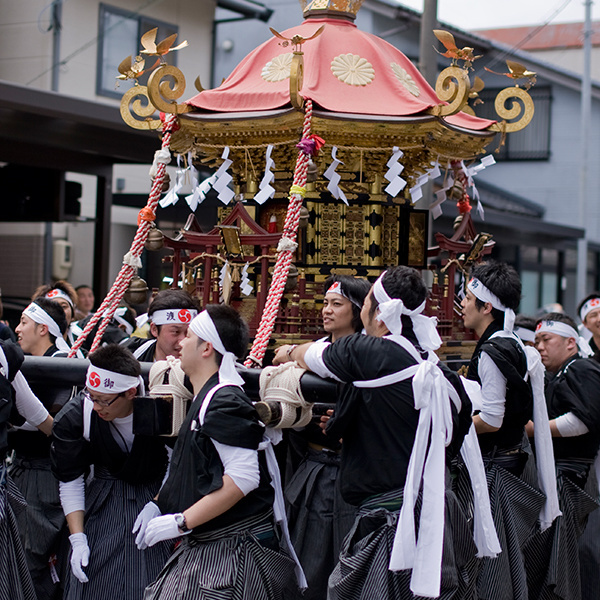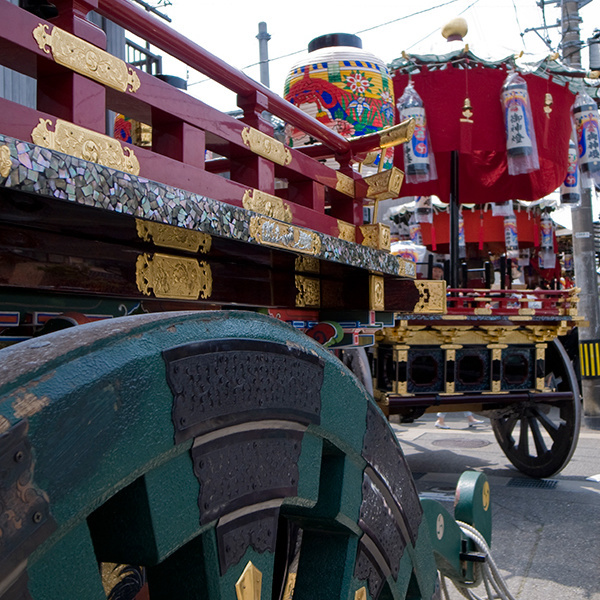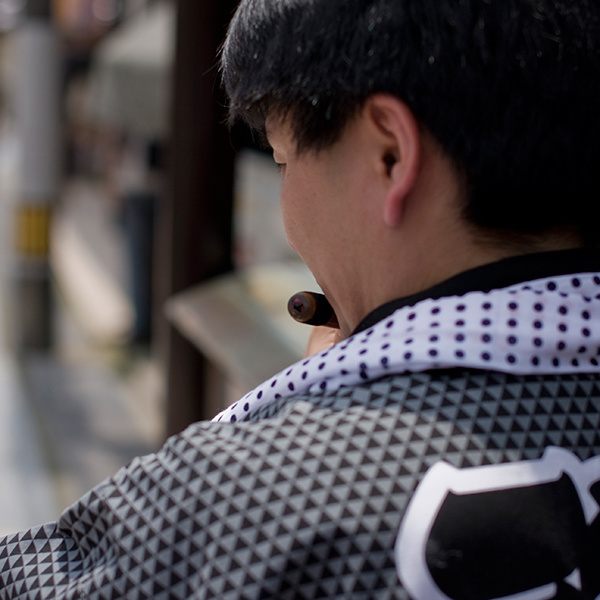Okaeri Matsuri Festival

Bizarre parade performed by local men wearing formal kimono with their sleeves tucked up! The sound of bugles livens up the festival!

Coco SHIZUO, Artex Inc.; Updated June 1, 2018
Place: Fujizuka Jinja Shrine (Nu-169, Minami-machi, Mikawa, Hakusan City)
Day-1: the third weekends of May
How to get to Mikawa district of Hakusan City: JR Kanazawa Station >> JR Mikawa Station

It begins with the sound of bugles at three in the morning!
At the mouth of the Tedori-gawa river in Hakusan City, one of the seven oldest port towns in Japan quietly exists. When the Kitamaebune was an important shipping route during the Edo (1603-1868) and the Meiji (1868–1912) periods, Mikawa district was called Motoyoshi-minato port.
On the first day of the festival, it begins with the sound of bugles at three in the morning. Though it sounds bit annoying for strangers like us, definitely exciting for the local boys. Once they hear the sound, they no longer keep sleeping in excitement. Then 90 minutes later, they meet up at the elementary school. As soon as they finish the opening ceremony there, they start marching to the Fujizuka Jinja shrine. It's still early in the morning. The stirring flourish of bugles resounds throughout the town.
13 three-wheeled floats and a portable shrine are gorgeous!
The beautiful portable shrine comes out from the shrine, and is paraded through the town till midnight. Sometimes excited people are climbing to the top of the holy object!!! Meanwhile 13 three-wheeled floats decorated with lanterns start moving from each area they belong. Around 9 am, all of them arrive and line up at the Nakamachi-dohri street. It looks gorgeous! Speaking of which, the floats are decorated with lacquer and gold. You know what? Mikawa district is well-known as a Buddhist-alter-producing area. So they fully show their technique for decorating floats.
It's a tradition that the local kids enjoy the festival with some doll warriors on the floats. The adults who drag out float, who carry the portable shrine, or who blow bugles, they all used to be one of them.


Enjoy both the day part and the night part!
Okaeri Matsuri starts before dawn and goes on till midnight on the first day, on the other hand it's held from 9 am to midnight on the second day. Enjoy both the day part and the night part if you can! The festival at night is like an illusion with the lights of street lanterns.
Taiko drums and flutes are indispensable instruments for Japanese traditional music. Furthermore in this festival, unusual sound of bugles will make you excited. The lion dance is called Kaga-Jishi, which is one of the Ishikawa's specialities since the age of Lord Maeda.
You can't miss the children in traditional costumes who are showing you a swordplay. They are not just adorable but also brave youngsters as Kaga (old Ishikawa) descendant! The lion head made of wood is a symbol as a lucky charm to keep evil spirits away.
You should also be aware that there are 13 garages for all floats just next to the shrine, by the way. It's quite impressive to see.

Kanazawa Area
Kenrokuenn Garden
Following Matsuo Bashô’s steps in Ishikawa - 1/6 [Introduction]
Following Matsuo Bashô’s steps in Ishikawa - 2/6 [Kanazawa]
Noto Area
Mitsukejima Island
Kaga Area
Following Matsuo Bashô’s steps in Ishikawa - 3/6 [Komatsu City]
Following Matsuo Bashô’s steps in Ishikawa - 4/6 [Natadera Temple]
Following Matsuo Bashô’s steps in Ishikawa - 5/6 [Yamanaka Onsen Town]
Following Matsuo Bashô’s steps in Ishikawa - 6/6 [Daishoji District]
Rosanjin in Yamashiro Onsen Town
Stroll Kanazawa in Rental Kimono - 1/2 [Kimono Rental]
Stroll Kanazawa in Rental Kimono - 2/2 [Kimono Stroll]
January
Enyukai: Geisha Party
February
Setsubun-Sai Festival
AUGUST
Issaki Hoh-Toh Matsuri
November
Enyukai: Geisha Party
